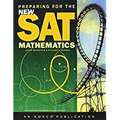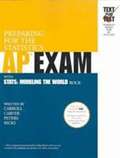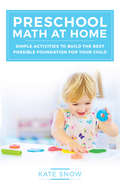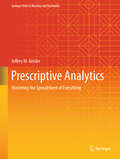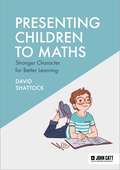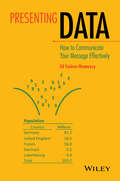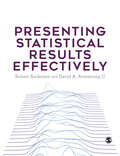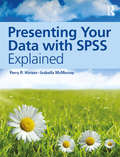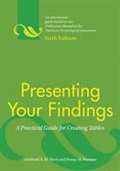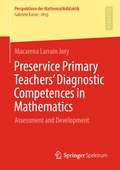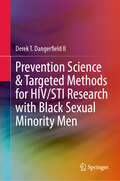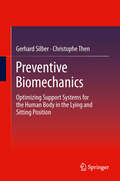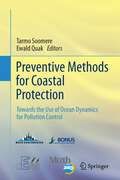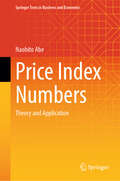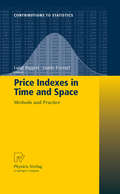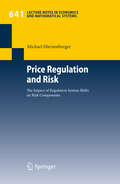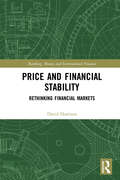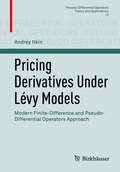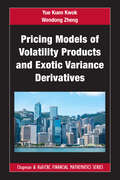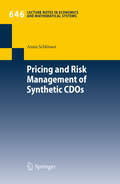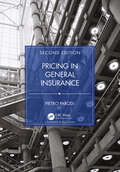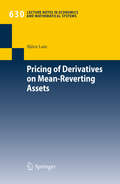- Table View
- List View
Preparing for the New SAT: Mathematics Student Edition
by Richard J. Andres Joyce BernsteinNIMAC-sourced textbook
Preparing for the Statistics AP Exam with Stats: Modeling the World Bock
by Anne M. Carroll Ruth E. Carver Susan A. Peters Janice D. RicksThis book presents Key Concepts, Skills, and Examples for the AP curriculum in a compact and student-friendly form.
Preschool Math at Home: Simple Activities to Build the Best Possible Foundation for Your Child
by Kate SnowGiving your preschooler a great start in math doesn’t have to be complicated. Learn how to use fun but purposeful games and activities to give your young child the best possible foundation. Preschool Math at Home will guide you step-by-step as you introduce your preschooler to the world of numbers. Your child will develop a thorough understanding of the numbers up to ten, including: counting comparing and ordering numbers recognizing written numerals beginning addition and subtraction All of the activities are quick and playful, with lots of movement, manipulatives, and games. Each takes less than five minutes, with no special materials needed other than a few household items. Play each game several times for a full year of preschool math curriculum.
Prescriptive Analytics: Mastering the Spreadsheet of Everything (Springer Texts in Business and Economics)
by Jeffrey M. KeislerThis book combines the quantitative decision-informing techniques of management science and operations research with the data-centric techniques found throughout the world of analytics. The material uses only standard Excel spreadsheet features and functions for creating models. Using a step-by-step approach, readers learn a unified architecture for sensitivity, scenario, simulation, decision, and optimization analysis. Spreadsheets with numerous screenshots support visual, hands-on learning (and provide some surprising innovations). Special influence diagrams and non-intimidating but accurate terminology help explain the logic of the models and calculations. Well-structured chapters include guideposts, enrichment, and curated links to valuable external resources. Readers are encouraged to own their learning and think about future trajectories for themselves and the field. This book helps all readers quickly learn tools and concepts to use right away and to expand throughout a career.
Presenting Children to Maths: Stronger Character for Better Learning
by David ShattockMathematics is not a universally popular subject, neither within nor outside of school. There are those who love it but many do not, and it is not uncommon for people to take a perverse pride in being bad at it.This book argues that, while much-needed improvements to mathematics teaching are necessary to address such issues, they are insufficient without also imbuing children with the character required to learn it effectively. Teachers of mathematics are responsible not only for applying skilful pedagogy but also for developing a productive learning culture within the mathematics classroom. We need to consider the emotional and social impact on children of teachers' own attitudes and beliefs about mathematics and how children should be taught it.Sometimes provocative and irreverent but always stimulating and lucid, Presenting Children to Maths is an original and profound discussion about how students' ability and success in mathematics depends largely on how their disposition and will are shaped towards learning it.
Presenting Children to Maths: Stronger Character for Better Learning
by David ShattockMathematics is not a universally popular subject, neither within nor outside of school. There are those who love it but many do not, and it is not uncommon for people to take a perverse pride in being bad at it.This book argues that, while much-needed improvements to mathematics teaching are necessary to address such issues, they are insufficient without also imbuing children with the character required to learn it effectively. Teachers of mathematics are responsible not only for applying skilful pedagogy but also for developing a productive learning culture within the mathematics classroom. We need to consider the emotional and social impact on children of teachers' own attitudes and beliefs about mathematics and how children should be taught it.Sometimes provocative and irreverent but always stimulating and lucid, Presenting Children to Maths is an original and profound discussion about how students' ability and success in mathematics depends largely on how their disposition and will are shaped towards learning it.
Presenting Data: How to Communicate Your Message Effectively
by Ed Swires-HennessyA clear easy-to-read guide to presenting your message using statistical dataPoor presentation of data is everywhere; basic principles are forgotten or ignored. As a result, audiences are presented with confusing tables and charts that do not make immediate sense. This book is intended to be read by all who present data in any form.The author, a chartered statistician who has run many courses on the subject of data presentation, presents numerous examples alongside an explanation of how improvements can be made and basic principles to adopt. He advocates following four key 'C' words in all messages: Clear, Concise, Correct and Consistent. Following the principles in the book will lead to clearer, simpler and easier to understand messages which can then be assimilated faster. Anyone from student to researcher, journalist to policy adviser, charity worker to government statistician, will benefit from reading this book. More importantly, it will also benefit the recipients of the presented data.'Ed Swires-Hennessy, a recognised expert in the presentation of statistics, explains and clearly describes a set of "principles" of clear and objective statistical communication. This book should be required reading for all those who present statistics.'Richard Laux, UK Statistics Authority'I think this is a fantastic book and hope everyone who presents data or statistics makes time to read it first.'David Marder, Chief Media Adviser, Office for National Statistics, UK'Ed's book makes his tried-and-tested material widely available to anyone concerned with understanding and presenting data. It is full of interesting insights, is highly practical and packed with sensible suggestions and nice ideas that you immediately want to try out.'Dr Shirley Coleman, Principal Statistician, Industrial Statistics Research Unit, School of Mathematics and Statistics, Newcastle University, UK
Presenting Statistical Results Effectively
by Robert Andersen David A. Armstrong IIPerfect for any statistics student or researcher, this book offers hands-on guidance on how to interpret and discuss your results in a way that not only gives them meaning, but also achieves maximum impact on your target audience. No matter what variables your data involves, it offers a roadmap for analysis and presentation that can be extended to other models and contexts. Focused on best practices for building statistical models and effectively communicating their results, this book helps you: - Find the right analytic and presentation techniques for your type of data - Understand the cognitive processes involved in decoding information - Assess distributions and relationships among variables - Know when and how to choose tables or graphs - Build, compare, and present results for linear and non-linear models - Work with univariate, bivariate, and multivariate distributions - Communicate the processes involved in and importance of your results.
Presenting Statistical Results Effectively
by Robert Andersen David A. Armstrong IIPerfect for any statistics student or researcher, this book offers hands-on guidance on how to interpret and discuss your results in a way that not only gives them meaning, but also achieves maximum impact on your target audience. No matter what variables your data involves, it offers a roadmap for analysis and presentation that can be extended to other models and contexts. Focused on best practices for building statistical models and effectively communicating their results, this book helps you: - Find the right analytic and presentation techniques for your type of data - Understand the cognitive processes involved in decoding information - Assess distributions and relationships among variables - Know when and how to choose tables or graphs - Build, compare, and present results for linear and non-linear models - Work with univariate, bivariate, and multivariate distributions - Communicate the processes involved in and importance of your results.
Presenting Your Data with SPSS Explained
by Perry R. Hinton Isabella McMurrayData Presentation with SPSS Explained provides students with all the information they need to conduct small scale analysis of research projects using SPSS and present their results appropriately in their reports. Quantitative data can be collected in the form of a questionnaire, survey or experimental study. This book focuses on presenting this data clearly, in the form of tables and graphs, along with creating basic summary statistics. Data Presentation with SPSS Explained uses an example survey that is clearly explained step-by-step throughout the book. This allows readers to follow the procedures, and easily apply each step in the process to their own research and findings. No prior knowledge of statistics or SPSS is assumed, and everything in the book is carefully explained in a helpful and user-friendly way using worked examples. This book is the perfect companion for students from a range of disciplines including psychology, business, communication, education, health, humanities, marketing and nursing – many of whom are unaware that this extremely helpful program is available at their institution for their use.
Presenting Your Findings: A Practical Guide For Creating Tables
by American Psychological Association Staff Adelheid Nicol Penny PexmanGone are the days when researchers and students were forced to search through journals for the best way to construct a table of results. Updated to reflect current standards in reporting and graphic displays, Presenting Your Findings: A Practical Guide for Creating Tables, Sixth Edition, provides invaluable guidance on the proper table format for a wide range of statistical analyses in an engaging and accessible format. The authors have included statistics commonly used in analyses to make the book as useful as possible for researchers and students and have organized the chapters according to the complexity of the statistic. Each chapter is devoted to a different statistic and provides a variety of examples of how data could best be displayed. Included for each statistic is a ""Play It Safe"" table that illustrates the most comprehensive formatting options. This definitive resource for how to build tables will eliminate editorial drudgery and free up your time for more gainful pursuits.
Preservice Primary Teachers’ Diagnostic Competences in Mathematics: Assessment and Development (Perspektiven der Mathematikdidaktik)
by Macarena Larrain JoryConsidering the relevance of teachers‘ diagnostic competence for understanding students’ thinking and providing effective learning opportunities, Macarena Larrain investigates the development of future primary school teachers’ diagnostic competence in error situations already during initial teacher education. Using video vignettes of classroom situations and samples of students’ work, the author focuses on fostering future teachers’ competence to identify students’ errors, elaborate hypotheses about the causes of those errors and to design appropriate strategies for supporting students in overcoming their misconceptions. She also describes aspects of teachers’ knowledge, beliefs and experience that are relevant for the competence and its development.
Prevention Science & Targeted Methods for HIV/STI Research with Black Sexual Minority Men
by Derek T. Dangerfield IIDespite substantial advances in HIV/STI treatment and prevention for general population health, sexual health disparities persist for Black gay, bisexual, and other Black sexual minority men (SMM). Strategies to build trust and overcome barriers are not well-established and solutions remain elusive. The contemporary prevention science landscape also requires updated perspectives in light of changing social policies, technological advancements, and prevention options. This book is the first to provide a comprehensive overview for sexual health prevention science using years of significant research from Dangerfield II et al. involving U.S. Black SMM in light of existing studies. This book identifies knowledge and practice gaps and proposes recommendations for innovative methods for academic collaboration with communities of practice. Researchers, clinicians, and public health practitioners will be guided through the sexual health research and intervention process using targeted contemporary studies to enhance their practice. This book serves as a valuable resource for enhancing the skills of emerging prevention scientists and clinicians. It also offers innovative strategies for experienced prevention experts to refine techniques and address persistent health disparities in sexual health outcomes. The book targets audiences across disciplines, including public health, sociology, psychology, nursing, medicine, anthropology, and population science and can be applied to marginalized communities globally. By bridging research, practice, and innovation, this book serves as a transformative resource for addressing sexual health disparities and empowering collaborative solutions to advance equity in the U.S. and around the globe.
Preventive Biomechanics
by Christophe Then Gerhard SilberHow can we optimize a bedridden patient's mattress? How can we make a passenger seat on a long distance flight or ride more comfortable? What qualities should a runner's shoes have? To objectively address such questions using engineering and scientific methods, adequate virtual human body models for use in computer simulation of loading scenarios are required. The authors have developed a novel method incorporating subject studies, magnetic resonance imaging, 3D-CAD-reconstruction, continuum mechanics, material theory and the finite element method. The focus is laid upon the mechanical in vivo-characterization of human soft tissue, which is indispensable for simulating its mechanical interaction with, for example, medical bedding or automotive and airplane seating systems. Using the examples of arbitrary body support systems, the presented approach provides visual insight into simulated internal mechanical body tissue stress and strain, with the goal of biomechanical optimization of body support systems. This book is intended for engineers, manufacturers and physicians and also provides students with guidance in solving problems related to support system optimization.
Preventive Methods for Coastal Protection: Towards the Use of Ocean Dynamics for Pollution Control
by Ewald Quak Tarmo SoomereThe aim of the book is to present for non-specialist researchers as well as for experts a comprehensive overview of the background, key ideas, basic methods, implementation details and a selection of solutions offered by a novel technology for the optimisation of the location of dangerous offshore activities in terms of environmental criteria, as developed in the course of the BalticWay project. The book consists of two parts. The first part introduces the basic principles of ocean modeling and depicts the long way from the generic principles to the practical modeling of oil spills and of the propagation of other adverse impacts. The second part focuses on the techniques for solving the inverse problem of the quantification of offshore areas with respect to their potential to serve as a source of environmental danger to vulnerable regions (such as spawning, nursing or also tourist areas). The chapters are written in a tutorial style; they are mostly self-contained and understandable for non-specialist researchers and students. They are carefully peer-reviewed by international experts. The goal was to produce a book that highlights all key steps, methods, models and data sets it is necessary to combine in order to produce a practically usable technology and/or decision support system for a particular sea region. Thus the book is useful not only as a description and a manual of this particular technology but also as a roadmap highlighting the complicated technical issues of ocean modeling for practical purposes. It describes the approaches taken by the authors in an understandable way and thus is useful for educational purposes, such as a course in industrially and environmentally relevant applications of ocean modeling.
Price Imputation and Other Techniques for Dealing with Missing Observations, Seasonality and Quality Change in Price Indices
by Fenella Maitland-Smith Paul A ArmknechtA report from the International Monetary Fund.
Price Index Numbers: Theory and Application (Springer Texts in Business and Economics)
by Naohito AbeThis textbook offers a comprehensive yet concise introduction to the theory behind price indices, covering the basics, historical background, necessary mathematical foundations, and contemporary cutting-edge theories. For those looking to study price indices, the most commonly used resources have traditionally been the comprehensive but voluminous CPI Manual, which is aimed at statistical practitioners, or Balk (2008), which, while covering theory concisely, requires advanced mathematical skills. This book is distinctive in that it (1) places emphasis on the relationship between price indices and economic theory, (2) presents cutting-edge methods and topics such as multilateral indices using scanner data and price measurement using Engel curves, and (3) provides explanations of essential mathematical techniques like functional equations, thus enabling self-study from the fundamentals to the forefront of modern index number theory.
Price Indexes in Time and Space: Methods and Practice
by Luigi Biggeri Guido FerrariThis book deals with the currently most relevant topics in price index numbers theory and practice. The problem of the harmonization of Consumer Price Indexes (CPIs) and the time-space integration of baskets is analyzed at the EU-zone level, with methodological and practical proposals on how to proceed for an overall treatment of the matter. Another issue is comparisons between Purchasing Power Parities (PPPs) and CPIs. Likewise, the construction of sub-indexes for households, economic and social groups is investigated, in order to obtain specific inflation measurement instruments. The book provides evidence from the most updated databases. Among the other issues treated in this book are spatial comparisons of price levels through PPPs and the international comparisons of macroeconomic aggregates, a re-consideration of index numbers theory, the measurement of production in non-market services, deflation problems, and price indexes in financial markets.
Price Regulation and Risk
by Michael HierzenbergerNatural monopolies are not subject to the market-based principle of competition. Consequently, it is necessary to control companies in such monopoly positions with regard to their pricing. In the future, it will become more and more important to consider a possible change in the regulation regime when the future-oriented costs of equity - both in terms of price regulation and for conducting capital market-oriented business valuations - are to be determined. Based on the principal-agent problem, the book explains this topic. The effect of a change in the regulation regime is presented in the form of two studies: an international secondary analysis of the effects on cost of equity based on event studies of the Anglo-Saxon area and a primary analysis based on the Austrian regulation policy for electricity and gas supply systems. The two studies arrive at similar results: The change from a rate-of-return regulation to incentive regulation systems leads to a significant increase in systematic risk.
Price and Financial Stability: Rethinking Financial Markets (Banking, Money and International Finance)
by David HarrisonWhy are financial prices so much more crisis-prone and unstable than real economy prices? Because they are doing different things. Unlike real economy prices, rooted in the real goods and services produced and exchanged, financial prices attempt to value future income flows from financial and capital assets. These valuations fluctuate erratically because expectations of the future fluctuate – and large liquid financial markets can amplify, rather than correct, these effects. The book builds on the insights of economists Frank Knight and John Maynard Keynes, that uncertainty of the future is essential to understand the processes of economic production and capital investment, and adds to this Karl Popper's general explanation of how expectations of an uncertain future are formed and tested through a trial and error process. Rather than relying on fluctuating financial prices to provide a guide to an uncertain future, it suggests a better approach would be to adopt the methods common to other branches of science, and create testable (falsifiable) theories allowing reasonable predictions to be made. In finance, the elements of one such theory could be based on the concept of forecasting yield from capital assets, which is a measurable phenomenon tending towards aggregate and long-term stability, and where there is a plentiful supply of historic data. By methods like this, financial economics could become a branch of science like any other. To buttress this approach, the widely accepted public policy objective of promoting real economy price stability could be widened to include financial price stability.
Pricing Derivatives Under Lévy Models
by Andrey ItkinThis monograph presents a novel numerical approach to solving partial integro-differential equations arising in asset pricing models with jumps, which greatly exceeds the efficiency of existing approaches. The method, based on pseudo-differential operators and several original contributions to the theory of finite-difference schemes, is new as applied to the L#65533;vy processes in finance, and is herein presented for the first time in a single volume. The results within, developed in a series of research papers, are collected and arranged together with the necessary background material from L#65533;vy processes, the modern theory of finite-difference schemes, the theory of M-matrices and EM-matrices, etc. , thus forming a self-contained work that gives the reader a smooth introduction to the subject. For readers with no knowledge of finance, a short explanation of the main financial terms and notions used in the book is given in the glossary. The latter part of the book demonstrates the efficacy of the method by solving some typical problems encountered in computational finance, including structural default models with jumps, and local stochastic volatility models with stochastic interest rates and jumps. The author also adds extra complexity to the traditional statements of these problems by taking into account jumps in each stochastic component while all jumps are fully correlated, and shows how this setting can be efficiently addressed within the framework of the new method. Written for non-mathematicians, this book will appeal to financial engineers and analysts, econophysicists, and researchers in applied numerical analysis. It can also be used as an advance course on modern finite-difference methods or computational finance.
Pricing Models of Volatility Products and Exotic Variance Derivatives (Chapman and Hall/CRC Financial Mathematics Series)
by Yue Kuen Kwok Wendong ZhengPricing Models of Volatility Products and Exotic Variance Derivatives summarizes most of the recent research results in pricing models of derivatives on discrete realized variance and VIX. The book begins with the presentation of volatility trading and uses of variance derivatives. It then moves on to discuss the robust replication strategy of variance swaps using portfolio of options, which is one of the major milestones in pricing theory of variance derivatives. The replication procedure provides the theoretical foundation of the construction of VIX. This book provides sound arguments for formulating the pricing models of variance derivatives and establishes formal proofs of various technical results. Illustrative numerical examples are included to show accuracy and effectiveness of analytic and approximation methods. Features Useful for practitioners and quants in the financial industry who need to make choices between various pricing models of variance derivatives Fabulous resource for researchers interested in pricing and hedging issues of variance derivatives and VIX products Can be used as a university textbook in a topic course on pricing variance derivatives
Pricing and Risk Management of Synthetic CDOs
by Anna SchlösserThis book considers the one-factor copula model for credit portfolios that are used for pricing synthetic CDO structures as well as for risk management and measurement applications involving the generation of scenarios for the complete universe of risk factors and the inclusion of CDO structures in a portfolio context. For this objective, it is especially important to have a computationally fast model that can also be used in a scenario simulation framework. The well known Gaussian copula model is extended in various ways in order to improve its drawbacks of correlation smile and time inconsistency. Also the application of the large homogeneous cell assumption, that allows to differentiate between rating classes, makes the model convenient and powerful for practical applications. The Crash-NIG extension introduces an important regime-switching feature allowing the possibility of a market crash that is characterized by a high-correlation regime.
Pricing in General Insurance
by Pietro ParodiBased on the syllabus of the actuarial profession courses on general insurance pricing – with additional material inspired by the author’s own experience as a practitioner and lecturer – Pricing in General Insurance, Second Edition presents pricing as a formalised process that starts with collecting information about a particular policyholder or risk and ends with a commercially informed rate. The first edition of the book proved very popular among students and practitioners with its pragmatic approach, informal style, and wide-ranging selection of topics, including: Background and context for pricing Process of experience rating, ranging from traditional approaches (burning cost analysis) to more modern approaches (stochastic modelling) Exposure rating for both property and casualty products Specialised techniques for personal lines (e.g., GLMs), reinsurance, and specific products such as credit risk and weather derivatives General-purpose techniques such as credibility, multi-line pricing, and insurance optimisation The second edition is a substantial update on the first edition, including: New chapter on pricing models: their structure, development, calibration, and maintenance New chapter on rate change calculations and the pricing cycle Substantially enhanced treatment of exposure rating, increased limit factors, burning cost analysis Expanded treatment of triangle-free techniques for claim count development Improved treatment of premium building and capital allocation Expanded treatment of machine learning Enriched treatment of rating factor selection, and the inclusion of generalised additive models The book delivers a practical introduction to all aspects of general insurance pricing and is aimed at students of general insurance and actuarial science as well as practitioners in the field. It is complemented by online material, such as spreadsheets which implement the techniques described in the book, solutions to problems, a glossary, and other appendices – increasing the practical value of the book.
Pricing of Derivatives on Mean-Reverting Assets
by Björn LutzThe topic of this book is the development of pricing formulae for European style derivatives on assets with mean-reverting behavior, especially commodity derivatives. For this class of assets, convenience yield effects lead to mean-reversion under the risk-neutral measure. Mean-reversion in the log-price process is combined with other stochastic factors such as stochastic volatility, jumps in the underlying and the price process and a stochastic target level as well as with deterministic seasonality effects. Another focus is on numerical algorithms to calculate the Fourier integral as well as to integrate systems of ordinary differential equations.
